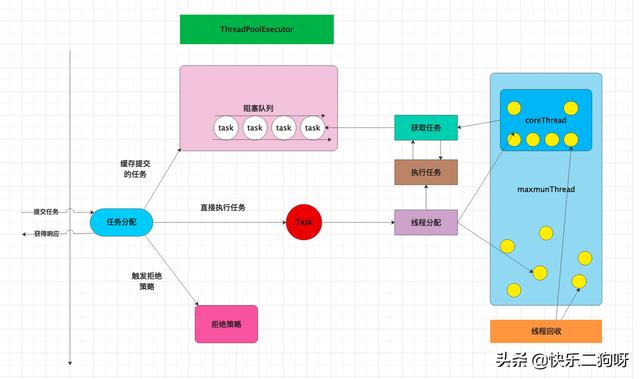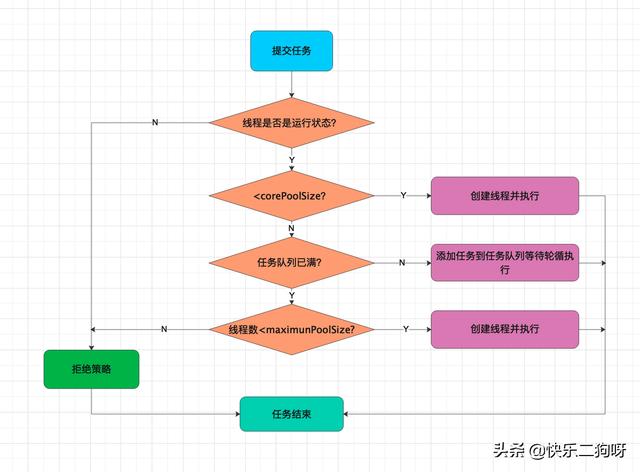前言
1.为什么需要线程池?线程池(Therad Pool)一种池化管理线程的思想。线程的频繁创建销毁,线程的调度伴随着较高的性能消耗。线程池就是对线程的统一管理,包括状态的管理,线程的复用,线程的创建,以及对线程最大数量的限制(线程作为计算机的稀缺资源,线程无休止的创建导致线程膨胀,必然会引起过分调度的问题,这样会适得其反)。JDK中实现的线程池,值得去深入理解。使用线程池会带来什么好处:
降低性能的开销:通过复用空闲的线程,减少线程创建带来的性能损耗。
提高响应速度:如果预先开启了空闲线程,那么任务达到时无需等待(线程创建的等待时间)可以立即执行。
统一管理:将线程统一管理,包括状态信息,线程的调度,分配,适当的时机销毁等。
可扩展性:由开发者扩展一些功能,如定时任务等。
ThreadPoolExecutor
1.作为线程顶层接口的Executor一个核心实现类,平时在开发过程中接触到的比较多,对ThreadPoolExecutor的深入了解有助于对线程池的设计和设计思想有更深的认识。这里主要设计几个重要的类Executor,ExecutorService,AbstractExecutorService,ThreadPoolExecutor。他们之间的关系也是从上到下:

Executor
1.顶层的线程池接口,目的是将提交任务与执行任务(Runnable)实现解耦分离,调用者无需关心内部的具体实现,只需要提供任务(Runnable、),获取响应。
public interface Executor {
/**
* Executes the given command at some time in the future. The command
* may execute in a new thread, in a pooled thread, or in the calling
* thread, at the discretion of the {@code Executor} implementation.
*
* @param command the runnable task
* @throws RejectedExecutionException if this task cannot be
* accepted for execution
* @throws NullPointerException if command is null
*/void execute(Runnable command);
} ExecutorService
1.同样是接口,继承自Executor,对其功能做了一些基础性的扩展。如结束任务shutdown、shutdownNow、submit等:
public interface ExecutorService extends Executor {
void shutdown();
List<Runnable> shutdownNow();
boolean isShutdown();
<T> Future<T> submit(Callable<T> task);
//.....
} AbstractExecutorService
1.上层的抽象类,将执行任务的流程串联,解耦下层,下层只需要关心执行任务的方法:
public abstract class AbstractExecutorService implements ExecutorService {
//ignore
} ThreadPoolExecutor
1.抽象类AbstractExecutorService的具体实现类,实现了线程池的初始化操作,管理自身与线程的生命周期,对提交的任务进行统一管理。分析线程池具体需要分析就是ThreadPoolExecutor的具体实现。
public class ThreadPoolExecutor extends AbstractExecutorService {
//ignore
} 2.首先熟悉主要的运行机制,对应到代码层面:

3.从execute()开始,作为用户提交的所有任务的调度入口,当用户提交任务到线程池,通过对线程池内状态的判断,线程数等限制参数来决定不同的执行流程。主要分为几个分支:
workerCount < corePoolSize 则创建一个线程来启动提交的任务
workerCount >= corePoolSize 此时判断任务队列是否已满,如果不满则添加到任务队列
workerCount >= corePoolSize && workerCount < maximumPoolSize 此时判断任务队列是否已满,如果已满,则创建一个线程来启动任务
workerCount >= maximumPoolSize 如果任务队列已满,则执行拒绝策略,而默认的拒绝策略(AbortPolicy)直接抛出异常
ThreadPoolExecutor-execute()
1.任务调度的入口:
public void execute(Runnable command) {
if (command == null)
throw new NullPointerException();
/*
* Proceed in 3 steps:
*
* 1. If fewer than corePoolSize threads are running, try to
* start a new thread with the given command as its first
* task. The call to addWorker atomically checks runState and
* workerCount, and so prevents false alarms that would add
* threads when it shouldn't, by returning false.
*
* 2. If a task can be successfully queued, then we still need
* to double-check whether we should have added a thread
* (because existing ones died since last checking) or that
* the pool shut down since entry into this method. So we
* recheck state and if necessary roll back the enqueuing if
* stopped, or start a new thread if there are none.
*
* 3. If we cannot queue task, then we try to add a new
* thread. If it fails, we know we are shut down or saturated
* and so reject the task.
*/int c = ctl.get();
if (workerCountOf(c) < corePoolSize) {
if (addWorker(command, true))
return;
c = ctl.get();
}
if (isRunning(c) && workQueue.offer(command)) {
int recheck = ctl.get();
if (! isRunning(recheck) && remove(command))
reject(command);
else if (workerCountOf(recheck) == 0)
addWorker(null, false);
}
else if (!addWorker(command, false))
reject(command);
}
//对方法稍加更改便于分析
public void execute(Runnable command) {
if (command == null) {
throw new NullPointerException();
}
int c = ctl.get();
//step1 workerCount < corePoolSiz 直接创建线程开启任务
if (workerCountOf(c) < corePoolSize) {
if (addWorker(command, true))
return;
c = ctl.get();
}
//step2 这一步判断了线程池的运行状态,并将任务提交到任务队列(如果添加成功则任务队列未满,添加失败则任务队列已满)
if (isRunning(c) && workQueue.offer(command)) {
int recheck = ctl.get();
if (! isRunning(recheck) && remove(command)) {
reject(command);
//step4 添加任务到任务队列成功后,开启一个新线程
} else if (workerCountOf(recheck) == 0) {
addWorker(null, false);
}
//step3 任务队列已满,addWorker内部判断了(任务队列已满的情况下判断了活动线程数是否小于maximunPoolSize)
//小于maximunPoolSize则开启新线程启动任务
} else if (!addWorker(command, false)) {
//大于maximumPoolSize执行了拒绝策略
reject(command);
}
} 2.整理流程图则为:

3.任务队列,线程池的另一个关键实现BlockingQueue,作为生产者与消费者模型将任务与线程之间解耦。通过阻塞队列缓存来不及处理的任务,而工作线程不断从阻塞队列中获取任务,如此循环。阻塞队列作为常用的数据结构,当阻塞队列为空时:获取元素的线程会等到有队列有数据在进行后序操作;当阻塞队列已经满时:添加元素的线程会等到队列容量释放。这是典型的生产者消费者模型,生产者不断的生产数据,而消费者不断地获取数据。配合响应的等待机制。那么常用的阻塞队列有几种实现:
ArrayBlockingQueue 数据实现的有界阻塞队列,FIFO,并且支持公平锁与非公平锁
LinkedBlockingQueue 链表实现的有界阻塞队列最大值为Integer.MAX_VALUE,有容量膨胀的风险
PriorityBlockingQueue 优先无界队列,默认自然排序,通过重写compareTo自定义排序规则,但是不能保证同优先级元素的顺序
DelayQueue 实现PriorityBlockingQueue的延迟队列,无界,可以指定时间延迟后获取数据
LinkedBlockingDeque 链表实现双向阻塞队列,head与tail都可以添加移除元素,并发情况下可以降低锁的竞争
SynchronousQueue 不存储元素的阻塞队列每一个put操作必须等待take操作,否则不能添加元素。支持公平与非公平锁。
ThreadPoolExecutor-Worker
1.Worker继承自AbstractQueuedSynchronizer,并实现了Runnable接口,继承AbstractQueuedSynchronizer主要考虑要实现独占锁:
private final class Worker extends AbstractQueuedSynchronizer implements Runnable {
/** Thread this worker is running in. Null if factory fails. */final Thread thread;
/** Initial task to run. Possibly null. */Runnable firstTask;
/**
* Creates with given first task and thread from ThreadFactory.
* @param firstTask the first task (null if none)
*/Worker(Runnable firstTask) {
setState(-1); // inhibit interrupts until runWorker
this.firstTask = firstTask;
//创建新线程
this.thread = getThreadFactory().newThread(this);
}
} 2.Worker内部持有了一个Thread与firstTask,而通过构造方法就是创建新线程的实现。以创建小于corePoolSiz创建工作线程为例分析addWorker方法:
if (workerCountOf(c) < corePoolSize) {
if (addWorker(command, true))
return;
c = ctl.get();
}
//command 不为空,core为true
private boolean addWorker(Runnable firstTask, boolean core) {
retry:
for (;;) {
//用于后序计算运行的线程数
int c = ctl.get();
//线程运行的状态
int rs = runStateOf(c);
// Check if queue empty only if necessary.
if (rs >= SHUTDOWN &&
! (rs == SHUTDOWN &&
firstTask == null &&
! workQueue.isEmpty()))
return false;
for (;;) {
//计算运行的线程数
int wc = workerCountOf(c);
if (wc >= CAPACITY ||
wc >= (core ? corePoolSize : maximumPoolSize))
return false;
if (compareAndIncrementWorkerCount(c))
break retry;
c = ctl.get(); // Re-read ctl
if (runStateOf(c) != rs)
continue retry;
// else CAS failed due to workerCount change; retry inner loop
}
}
boolean workerStarted = false;
boolean workerAdded = false;
Worker w = null;
try {
//创建了一个新worker,之前提到,通过构造方法创建了一个新的线程
w = new Worker(firstTask);
final Thread t = w.thread;
if (t != null) {
//这个操作是要获取全局锁的
final ReentrantLock mainLock = this.mainLock;
mainLock.lock();
try {
// Recheck while holding lock.
// Back out on ThreadFactory failure or if
// shut down before lock acquired.
int rs = runStateOf(ctl.get());
if (rs < SHUTDOWN ||
(rs == SHUTDOWN && firstTask == null)) {
if (t.isAlive()) // precheck that t is startable
throw new IllegalThreadStateException();
//workers基于HashSet,将任务包装成workers存储
workers.add(w);
int s = workers.size();
if (s > largestPoolSize)
largestPoolSize = s;
workerAdded = true;
}
} finally {
mainLock.unlock();
}
if (workerAdded) {
//直接启动任务(worker实现了runnable接口,线程启动,那么就看run方法)
t.start();
workerStarted = true;
}
}
} finally {
if (! workerStarted)
addWorkerFailed(w);
}
return workerStarted;
} 3.run()方法中:
/** Delegates main run loop to outer runWorker */public void run() {
runWorker(this);
}
//还是以小于corePoolSize为例
final void runWorker(Worker w) {
Thread wt = Thread.currentThread();
//由于firstTask即为添加的command,不为空
Runnable task = w.firstTask;
w.firstTask = null;
w.unlock(); // allow interrupts
boolean completedAbruptly = true;
try {
//getTask即从阻塞队列中获取任务执行
while (task != null || (task = getTask()) != null) {
w.lock();
// If pool is stopping, ensure thread is interrupted;
// if not, ensure thread is not interrupted. This
// requires a recheck in second case to deal with
// shutdownNow race while clearing interrupt
if ((runStateAtLeast(ctl.get(), STOP) ||
(Thread.interrupted() &&
runStateAtLeast(ctl.get(), STOP))) &&
!wt.isInterrupted())
wt.interrupt();
try {
beforeExecute(wt, task);
Throwable thrown = null;
try {
//前序做一些状态检查,到这里真正执行任务
task.run();
} catch (RuntimeException x) {
thrown = x; throw x;
} catch (Error x) {
thrown = x; throw x;
} catch (Throwable x) {
thrown = x; throw new Error(x);
} finally {
afterExecute(task, thrown);
}
} finally {
task = null;
w.completedTasks++;
w.unlock();
}
}
completedAbruptly = false;
} finally {
//当获取不到任务时主动回收自身
processWorkerExit(w, completedAbruptly);
}
} 4.整个申请线程的逻辑图(爬的):

为什么不推荐使用Executors创建线程池?
1.在Java的并发包下,实现了Executors类,这个类的主要作用就是提供了四种线程池的创建方式(工厂模式),但是底层的实现还是基于ThreadPoolExecutor,现在看看到底为什么不推荐使用这种创建方式来创建线程池。
newFixedThreadPool
1.对应源码中的构造方法:
创建一个线程大小固定的线程池
public static ExecutorService newFixedThreadPool(int nThreads) {
return new ThreadPoolExecutor(nThreads, nThreads,
0L, TimeUnit.MILLISECONDS,
new LinkedBlockingQueue<Runnable>());
}
对应到ThreadPoolExecutor,也即corePoolSize = maximumPoolSize
但是使用的是LinkedBlockingQueue,经过之前的分析,显然这个基于链表的阻塞队列
线程缓存的最大值为MAX_VALUE,显然如果任务堆积存在OOM的风险。
同时使用的是默认的拒绝策略,直接抛出异常,不支持拒绝策略的扩展。 newSingleThreadExecutor
1.创建一个单线程的线程池:
public static ExecutorService newSingleThreadExecutor() {
return new FinalizableDelegatedExecutorService
(new ThreadPoolExecutor(1, 1,
0L, TimeUnit.MILLISECONDS,
new LinkedBlockingQueue<Runnable>()));
}
用一个线程执行任务,相当于串行,也就是可以保证任务按照顺序执行。当一个任务依赖于上一个任务的情景可以使用这个。
缺点也是一样的,容易造成任务积压,不时候高并发下操作。 newCachedThreadPool
1.可缓存的线程池:
public static ExecutorService newCachedThreadPool() {
return new ThreadPoolExecutor(0, Integer.MAX_VALUE,
60L, TimeUnit.SECONDS,
new SynchronousQueue<Runnable>());
}
SynchronousQueue由于自身的特点,当新任务到来是创建新的线程,如果有空闲线程则复用,超时时间为60S
可以看到的是,虽然线程是弹性创建,但是线程的最大值为Integer.MAX_VALUE,同样存在内存OOM的风险。 newScheduledThreadPool
1.定时任务线程池:
public static ScheduledExecutorService newScheduledThreadPool(int corePoolSize) {
return new ScheduledThreadPoolExecutor(corePoolSize);
}
public ScheduledThreadPoolExecutor(int corePoolSize) {
super(corePoolSize, Integer.MAX_VALUE, 0, NANOSECONDS,
new DelayedWorkQueue());
}
public ScheduledThreadPoolExecutor(int corePoolSize,
ThreadFactory threadFactory) {
super(corePoolSize, Integer.MAX_VALUE, 0, NANOSECONDS,
new DelayedWorkQueue(), threadFactory);
}
虽然指定了corePoolSize的大小,但是maximunPoolSize为Integer.MAX_VALUE,网上很多说创建固定大小的线程池。
WTF?这是固定大小,应该抄的同一家吧。缺点同样是存在OOM的风险,通过DelayedWorkQueue延迟队列实现任务定时执行。 2.可以发现几种默认的线程池都是使用ThreadPoolExecutor默认的拒绝策略,也即不支持扩展自身的拒绝策略。而ThreadPoolExecutor的拒绝策略主要是四种:
ThreadPoolExecutor.AbortPolicy 默认的拒绝策略,但任务无法添加时直接抛出异常RejectedExecutionException,通知到上层
ThreadPoolExecutor.DiscardPolicy 丢弃任务,但是不抛出异常
ThreadPoolExecutor.DiscardOldestPolicy 丢弃队列最前的任务,然后重新提交被拒绝的任务。
ThreadPoolExecutor.CallerRunsPolicy 由调用者所在的线程处理此次任务 推荐创建线程池的方法
1.基于ThreadPoolExecutor合理配置,包括核心线程数,最大线程数,最大缓存队列数,当然还包括自己的拒绝策略,通过集合业务实现定制化。通过分析Executors发现底层的实现还是基于ThreadPoolExecutor,并存在很多风险,作为开发者在了解ThreadPoolExecutor特性后完全可以实现切合自身业务的线程池,而Executors仅仅作为参考。


